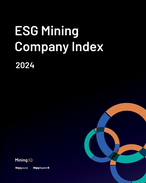Strategically positioned on the Arabian-Nubian Shield with the Gulf of Suez at its head, Egypt sits on a hotbed of natural resources. In recent years, the country has begun its pivot towards mining, with an ambitious plan to attract investment into the country and increase mining's share of GDP five-fold.
At the FMF 2025, Egypt was one of many countries keenly seeking to improve ties with the affluent Kingdom of Saudi Arabia – one of Egypt's neighbours and most significant trade partners.
With ambitious reforms underway, Egypt's government wants to position the country as a regional mineral leader, and contributor to Saudi Arabia's ‘super region'.
Egyptian Mineral Resources Authority (EMRA) Chairman Yasser Ramadan spoke exclusively with Mining Magazine about the country's vision, outlining its advantages within the mining ecosystem of the Arabian-Nubian Shield.
YOU MIGHT ALSO LIKE
"Egypt's main sell is all the commodities and minerals which are found in the Arabian-Nubian Shield. It's the other page of the book from Saudi Arabia," Ramadan said. "We have many encouraging incentives, strong infrastructure, widespread logistics facilitation, and political stability."

Economic change
Recently, Egypt's minister of Petroleum and Mineral Resources Karim Badawi announced sweeping initiatives to modernise the country's mining sector and increase its contribution to GDP from the current 1% to 5–6% by 2030.
A part of these efforts will be the launch of a Digital Mining Platform in early 2025, which aims to create a more transparent and investor-friendly environment.
"One of the flagship reforms is the transformation of the Mineral Resources Authority into an economic entity, a move intended to streamline operations and align Egypt's mining framework with international standards," the country's State Information Service said in a release.
"This initiative is complemented by the removal of bureaucratic barriers, the development of investment models for gold exploitation, and the modernisation of administrative processes."
At the FMF, Badawi underscored the importance of international collaboration in talks with ministers from the UK and Saudi Arabia.
Enhancing human capital
Speaking with Mining Magazine, Ramadan stressed the role of capacity building in Egypt's mining strategy.
"One of the most important pillars of the development strategy is capacity building," he said. EMRA has implemented multifaceted training programs, international trade delegations and knowledge exchanges in China, Japan, Senegal, and Tanzania, according to Ramadan.
The emphasis on nurturing local talent aligns with Egypt's broader ambition to develop its mining sector, not only as an economic engine, but also as a driver of skilled employment opportunities.
International partnerships in motion
At the FMF, Badawi met with UK Industry Minister Sarah Jones, who underscored the potential for Egypt to collaborate with British entities. The discussions explored leveraging UK expertise in finance, technology, and education to bolster Egypt's mining industry.
As part of this effort, Egypt has been invited to participate in London's Minerals Week in October 2025.
The country also recently launched a global tender inviting investors to explore kaolin sand and silica sand. This initiative complements efforts to streamline regulations and reduce bureaucratic hurdles, providing a clear path for private-sector engagement.
A new opportunity
Reflecting on Egypt's evolution over the past six years, Ramadan called on international stakeholders to seize the opportunities in the revitalized sector. "Any investor who comes to Egypt is more than welcome. They will find much cooperation and many incentives to encourage them to start their investment," he said.
As of December 2024, notable players like Canada's Barrick Gold have already signed initial agreements, signaling growing confidence in Egypt's reformed investment framework.
"Egypt has started a new era of focus on the mining sector," Ramadan concluded. "We invite all investors to see how much Egypt has changed over the last six years."

























